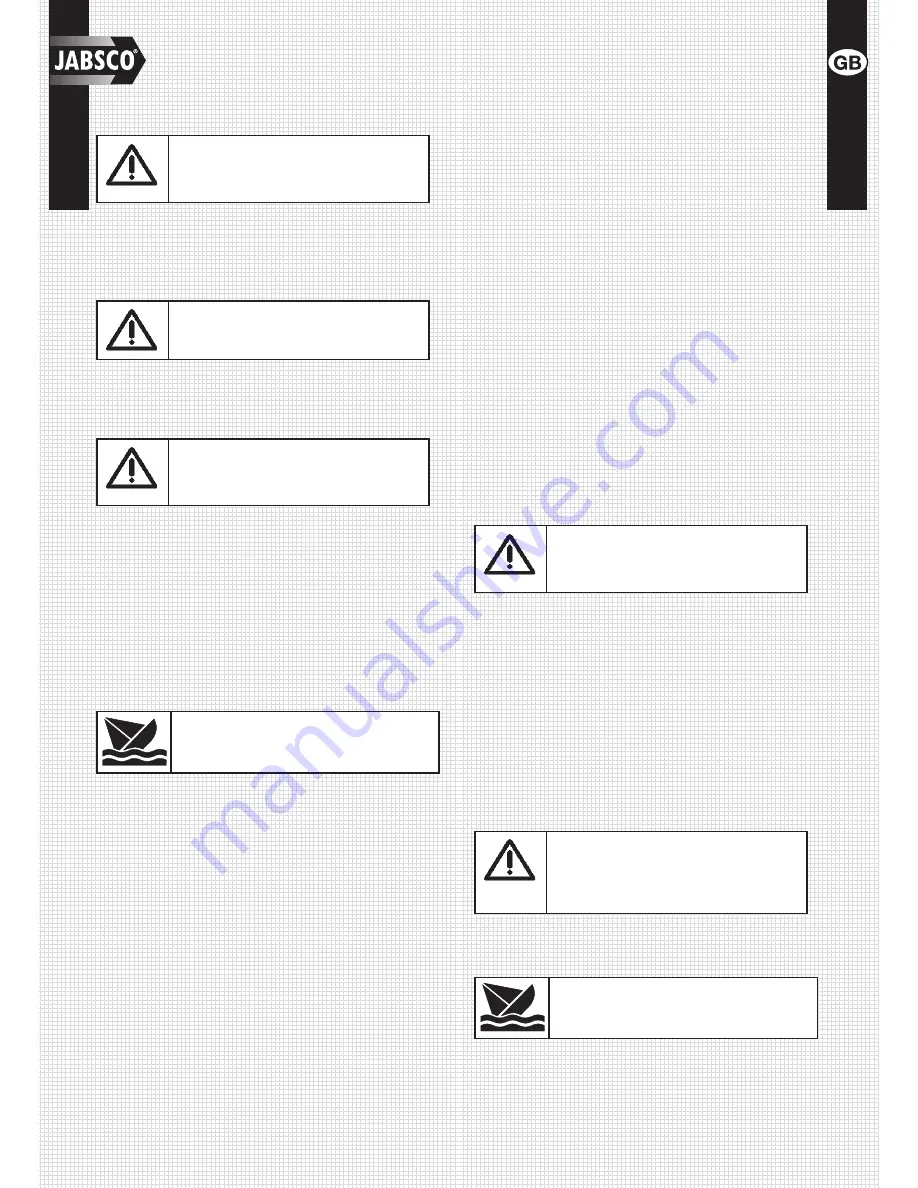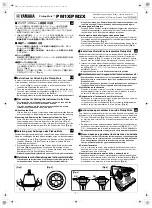
6
3. Cleaning
Caution: Do NOT use aggressive chemical
agents such as Acetone or Bleach because
plastic parts may crack and the enamel
coating on the seat and lid may blister.
To clean the bowl, use any liquid or cream ceramic
•
cleaner.
To clean the rest of the toilet, including the seat and lid,
•
use a non-abrasive liquid cleaner. Polish with a dry cloth
only.
CAUTION: Do not use abrasive pads on any
part of the toilet and do not use cream
cleaners except for the bowl.
•
To disinfect the toilet, use a liquid disinfectant diluted in
accordance with the manufacturer's instructions. You
may apply it to all parts of the toilet using a sponge or
soft brush as necessary.
CAUTION: Do not use thick liquid toilet
cleansers or neat bleach. They may damage
the valves, gaskets, seals and the enamel
coating of the seat and lid.
Servicing Instructions
Jabsco manual toilets do not normally require maintenance
during the season, provided that they are winterised in the
autumn and overhauled in the spring. However, any toilet will
benefit from:
Thorough flushing - refer to OPERATING
•
INSTRUCTIONS for NORMAL USE.
Regular use - if not used regularly lubrication is
•
beneficial - refer to OPERATING INSTRUCTIONS for
FIRST USE.
Regularly check all fastenings for tightness and leaks.
•
HAZARD RISK - Leaks
If the toilet is connected to ANY through-hull fittings and, if the
toilet or the pipework develops a minor leak, it can suddenly
become a major leak that allows water to flood in, causing the
craft to sink, which may result in loss of life. Therefore, if ANY
leak develops you MUST repair it immediately.
REPAIR LEAKS IMMEDIATELY!
1. Servicing & Winterisation - preparation
Jabsco manual toilets are designed to be user serviceable and
no special skills or tools are required.
Flush the toilet in accordance with the OPERATING
•
INSTRUCTIONS for NORMAL USE and, in particular,
ensure that all waste has left the discharge pipework and
that the bowl is empty.
CLOSE BOTH SEACOCKS (even if secondary valves
•
are fitted)
If the vessel is being wintered afloat, WIRE SEACOCKS
•
SHUT
Be ready to mop up any water that may come out of the
•
system.
2. Servicing - Seal replacement
If water begins to leak around the piston rod (key 29) at the top
of the pump, the seal assembly (key 18) is worn and must be
replaced.
YOU WILL need:
❏
A Seal housing Assembly 29044-3000.
Unscrew the seal housing assembly (key 18) using a
•
24mm (15/16") spanner and remove the entire piston rod
assembly from the toilet.
Wrap some tape around the piston rod within 16mm (
•
5/8")
of the handle. Grip the piston rod through the tape,
unscrew the handle and remove the bumper washer (key
25). Remove the tape.
Slide the old seal assembly off the piston rod. Wrap one
•
turn of tape around the thread at the top of the piston
rod to protect the new seal and slide the new seal
assembly onto the piston rod. Remove the tape from the
thread.
Wrap some tape around the piston rod within 16mm (
•
5/8")
of the handle. Grip the piston rod through the tape and
replace the bumper washer and handle. Remove the tape
from the piston rod.
Slide the whole assembly back into the pump cylinder
•
and tighten in place.
CAUTION: Gripping the piston rod with a tool
anywhere except on the 16mm (5/8") below
the handle damages the surface in a way
that causes rapid seal failure.
3. Servicing - Winterisation
Drain the complete system, both as protection against frost
damage and to discourage the growth in the pipework of
anaerobic bacteria that cause unpleasant smells.
Open any secondary valves.
•
Remove the base drain plug (key 8).
•
Disconnect the discharge flange (key 32) from the pump
•
(avoiding the need to remove the hose from the
discharge elbow (key 34).
Loosen hose clips and disconnect the hose ends from
•
both seacock hose tails. Pump the handle (key 17) to
drain the toilet pump and ensure that all water is drained
from the toilet system.
CAUTION: The use of anti-freeze is NOT
RECOMMENDED, as it is impossible to
ensure that it penetrates the complete toilet
system. If, for any reason, anti-freeze is used
it MUST be glycol based.
If you plan to overhaul the toilet in the spring, this is a good time
to disassemble it and take the components ashore to make the
overhaul easier.
HAZARD RISK - Seacocks opened by
mistake
If you leave the toilet disassembled and, if the seacocks are
opened when the craft is afloat, water will flood in and may
cause the craft to sink, which may result in loss of life.
Therefore, you MUST attach a warning notice to the seacocks
and, if possible, wire the seacocks shut.



























